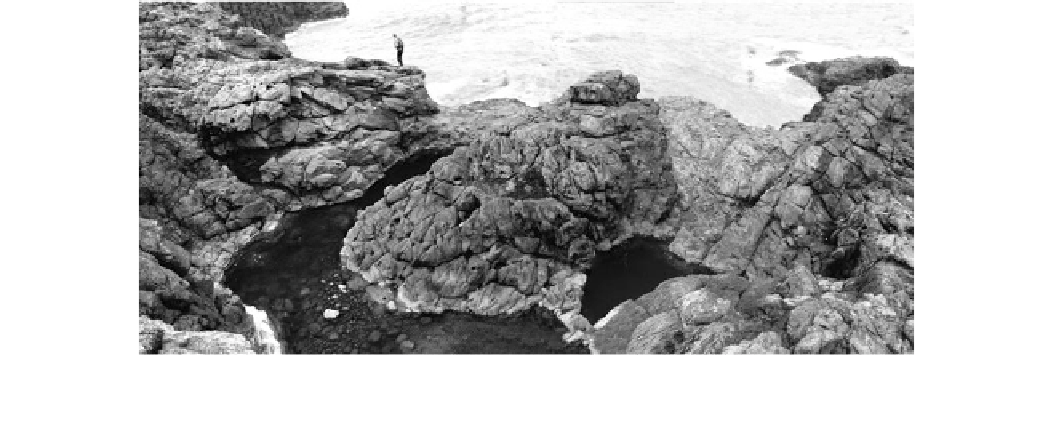Geoscience Reference
In-Depth Information
Fig. 3.26
Whirlpool bored into bedrock on the south side of
Atcheson Rock, New South Wales, Australia. The presence of drill
holes and smaller potholes at the bottom indicates the existence of
cavitation and multiple vortices, respectively. Helical flow operated in
a counter clockwise direction around the central plug
First, there is a sudden increase in flow velocity as
momentum is conserved and vortex formation is initiated.
Second, the sudden velocity increase is sufficient for cavi-
tation and creates lift forces that can pluck blocks of bed-
rock from the bed at the front of a platform. Eq.
2.17
can be
used to calculate theoretical velocities on some of the ramp
surfaces. If the height of the tsunami wave is equivalent to
the cliff fronting ramps, then the calculated velocities can
exceed 20 m s
-1
. These velocities are well in excess of the
10 m s
-1
threshold required for cavitation (Baker
1978
).
The third phenomenon, flow reattachment, occurs if flow
separates from the bed at the crest of a rocky promontory
(Allen
1984
; Bryant and Young
1996
). This occurs at
breaks of slope greater than 4. Rock platforms overwashed
by tsunami have changes in slope much greater than this.
Some distance downstream, depending upon the velocity of
the jet, water must reattach to the bed. Where it does, flow is
turbulent and impingement on the bed is highly erosive.
Standing waves may develop in the flow, leading to large
vertical lift forces under crests. The bedrock plucking at the
front of platforms and in the lee of crests is a product of this
process.
S-forms spatially change their shape depending upon the
degree of flow impingement and vortex orientation
(Fig.
3.27
). In coastal environments, the flow by tsunami
overwashing bedrock surfaces is not confined. The high
velocity and sudden impact of the vortex on the bedrock
surface causes the vortex to ricochet upwards and rapidly
separate from the bed (Allen
1984
; Shaw
1988
). This pro-
duces features that begin as shallow depressions, scour
downflow, and then terminate suddenly leaving a form that
is gouged into the bedrock surface with the steep rim
downstream. Narrow longitudinal vortices impinging upon
the bed at a low angle produce muschelbrüche that become
sichelwannen and V-shaped grooves at higher angles of
attack (Kor et al.
1991
;Shaw
1994
). Obstacles in the flow
boundary layer form horseshoe vortices. As flow impinges
upon an obstacle, higher pressures are generated that cause
flow deflection and separation from the bed. This generates
opposing, rotating vortices that wrap around the obstacle
like a horseshoe or hairpin. The vortices scour into the
bedrock surface downflow. Because these vortices lie
within the boundary layer, they are subject to intense
shearing by the overlying flow. This shearing fixes the
vortices in position and keeps them straight. Shaw (
1994
)
theorized that horseshoe or hairpin vortices produce flutes
that are progressively eroded into a rock surface as long as
high velocity is maintained. Flutes form in the coastal
environment under the same process (Fig.
3.20
). Helix or
spiral vortices in the vertical direction have been linked to
pothole formation (Alexander
1932
). At the largest scale the
inverted keel-like stacks shown in Fig.
3.24
formed
between horizontal, helical (eggbeater) vortices. These
helical vortices, besides eroding vertical stacks, have the
capacity
to
bore
caves
into
cliffs
and
form
arches
(Fig.
3.25
).
Multiple-vortex formation occurs at the largest scale and
includes kolks and tornadic flow. Kolks are near-vertical
vortices whose erosive power is aided by turbulent bursting
(Baker
1978
,
1981
). They are produced by intense energy
dissipation in upward vortex action. The steep pressure
gradients across the vortex produce enormous hydraulic lift
forces. Kolks require a steep energy gradient and an irreg-
ular rough boundary to generate flow separation. These
conditions are met when the tsunami waves first meet the
steeper sides of headlands; however, the process does not
account for the formation of whirlpools. Kolks may also be
formed by macro turbulence whereby eddies grow within
larger rotational flow. This latter concept has been invoked
to account for the formation of tornadoes and incorporated

